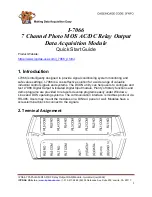
Section 8. Operation
•
Formatting memory drives.
•
Deleting data files associated with the previously running program.
When power is connected to the CR1000, it searches for
powerup.ini
and
executes the command(s) prior to compiling a program.
Powerup.ini
performs
three operations:
1. Copies the program file to a memory drive
2. Optionally sets a file run attribute (
Run Now
,
Run on Power Up
, or
Run
Always
) for the program file.
3. Optionally deletes data files stored from the overwritten (just previous)
program.
4. Formats a specified drive.
Execution of
powerup.ini
takes precedence during CR1000 power-up. Although
powerup.ini
sets file attributes for the uploaded programs, its presence on a drive
does not allow those file attributes to control the power-up process. To avoid
confusion, either remove the external drive on which
powerup.ini
resides or
delete the file after the power-up operation is complete.
8.3.4.4.1 Creating and Editing Powerup.ini
Powerup.ini
is created with a text editor on a PC, then saved on a memory drive
of the CR1000. The file is saved to the memory drive, along with the operating
system or user program file, using the
datalogger support software
(p. 654)
File
Control |
Send
(p. 515)
command.
Note
Some text editors (such as MicroSoft
®
WordPad
®
) will attach header
information to the powerup.ini file causing it to abort. Check the text of a
powerup.ini file in the CR1000 with the CR1000KD Keyboard Display to see
what the CR1000 actually sees.
Comments can be added to the file by preceding them with a single-quote
character ('). All text after the comment mark on the same line is ignored.
Syntax
Syntax for
powerup.ini
is:
Command,File,Device
where,
•
Command
is one of the numeric commands in table
Powerup.ini Commands
(p. 388).
•
File
is the accompanying operating system or user program file. File name
can be up to 22 characters long.
•
Device
is the CR1000 memory drive to which the accompanying operating
system or user program file is copied (usually CPU:). If left blank or with an
invalid option, default device will be CPU:. Use the same drive designation
as the transporting external device if the preference is to not copy the file.
387
Summary of Contents for CR1000
Page 2: ......
Page 4: ......
Page 6: ......
Page 32: ......
Page 36: ......
Page 38: ......
Page 40: ......
Page 60: ...Section 4 System Quickstart Figure 16 PC200W View Line Graph 60 ...
Page 96: ......
Page 98: ...98 ...
Page 302: ......
Page 453: ...Section 8 Operation Figure 115 Using the Keyboard Display 453 ...
Page 456: ...Section 8 Operation Figure 118 Real Time Custom 456 ...
Page 457: ...Section 8 Operation 8 8 1 3 Final Memory Tables Figure 119 Final Memory Tables 457 ...
Page 458: ...Section 8 Operation 8 8 2 Run Stop Program Figure 120 Run Stop Program 458 ...
Page 460: ...Section 8 Operation Figure 122 File Edit 460 ...
Page 461: ...Section 8 Operation 8 8 4 PCCard Memory Card Display Figure 123 PCCard CF Card Display 461 ...
Page 478: ......
Page 506: ......
Page 536: ......
Page 636: ......
Page 642: ......
Page 644: ......
Page 676: ......
Page 677: ......
















































